AbstractIn the final installment of Decisions in Paradise three part project, Nik is faced with the challenges of implementing the proposed solutions for expansion of the Children's Home to the South Pacific island country of Kava. Nik applies critical thinking decision making skills to determine the factors affecting decision implementation including his proposed solutions. Because of the massive requirements of the project, Nik solicits the assistance of international relief organizations; while keeping in mind the ethical implications from stakeholders. Nik overcomes the challenges and obstacles using his newly acquired skills to make a children's home more than a possibility but a reality in Paradise.
Decisions in Paradise Part 3Part 1 of Decisions in paradise reveals the challenges Nik faces in expanding the Church of God Children's Home to the South Pacific island country of Kava. Part 2 of Decisions in Paradise applied a decision making technique to identify solutions, provide an analysis of the specific steps needed in applying a specific decision making technique; and explained how the decision making model impacts the proposed solutions.
In this final chapter of the three part series, Nik takes advantage of the opportunity of show off his critical thinking skills to describe his rationale and plan for implementation for the proposed solutions for Children's Home to establish a greater presence on Kava by determining the factors affecting decision implementation of the expansion of the children's home to Kava, evaluating resources and actions required for implementation of his proposed solutions; and finally Nik evaluates the ethical implications from stakeholders perspectives of his proposed solutions.
Decision ImplementationBecause Kava has been decimated by a number of natural disasters, recovery will require more resources than the tiny island country is able to provide their residents. Nik's solution is to communicate with the government the benefits of World Food Programme (WFP). WFP will send consultants to the devastated island to assess the need for humanitarian aid. Consultants will develop an Emergency Operation (EMOP) then make an appeal to the international community for monetary donations and supplies. To cover immediate need the WFP Director of the country receiving assistance may borrow up to $500,000. These funds are usually provided for the first three months of the operation. (WFP 2009).
The EMOP will include a budget as well as well as designated areas where provisions may be stored and distributed. The best route to ship the food and supplies will be determined by WFP. Before the supplies reach their destination, upgrades to ports are often required along with securing of warehouses where provisions may be stored.. As supplied begin to arrive in Kava, government agencies will announce where and when residents may be permitted to access relief aid. Those receiving aid will be required to register. This information will provide vital information to WFP required to track and monitor distribution for assistance with restocking depleted supplies (WFP 2009).
Before Nik can continue with plans for expansion of the Children's Home in Kava, he must consider issues which challenge his decision. Because Kava is located in a disaster prone area of the South Pacific, Nik proposes natural disaster training. With 50^ of the population of Kava below the age of 15, Disaster Training International (DTI) will train adults who work directly with Children. Those included in the training may be "elementary school staff, staff of child caring and preschool programs, family child care providers, adults working with children in religious organizations, or other adults working with young children" (C., Beryl n.d.). Those trained will receive instruction in how to prepare and plan for disasters, who should be involved when responding to disasters, supplies need during disasters and preparing children for disasters.
As a result of the large number of natural disasters which pummel the island, Nik proposes a more efficient early warning system. This system would alert residents of impending disasters such as typhoons, tsunamis, and earthquakes, Nik will, along with government agencies to work with engineers to develop and install highly technical systems in key areas throughout the island. The system would analyze data from around the island and the South Pacific and immediately warn residents of coming disasters. The new warning systems would require educating the residents in what they should do when the warnings are sounded.
With the threat of Hiv/Aids epidemic, Nik has proposed a plan which includes assistance from United Nations Educational Scientific and Cultural Organization. UNESCO provides comprehensive education and sector response to HIV and AIDS with programs and activities in five different components:"Quality education, including cross-cutting issues;Content, curriculum and learning materials;Educator training and support;Policy, management and systems; andThe use of approaches and illustrative entry points" (UNESCO 2009).
Ethical Implications of StakeholdersIn order to gain the support in the implementation of decisions, stakeholders must be included in the decision making process. The ethical implications of the stakeholders relate to the moral principles of values. Therefore, the stakeholders have an interest in the standard of behavior that indicates how one is to operate. Very often organization must choose between moral and profit. Only a few are able to achieve both, even though ethical issues arise in nearly every major decision. Issues of concern include: fairness, justice, rightness, or wrongness. Stakeholders have a valid interest in the organization and may easily influence the way business is conducted.
The responsibility of management is to conduct business according to ethical standards. Organizations must incorporate a set of standards the same as individuals would set. In addition, organizations have certain social responsibilities which must be met. Responsibilities include the way customers, employees, and society as a whole are treated.
Because Children's Home is a Christian nonprofit organization, the stakeholder's ethical interests are of the highest moral standards. Consequently, Nik must include these standards when implementing the proposed decisions. Children's Home is a service organization whose mission is to provide a positive, safe living environment for hurting abused, dependent neglected, and at risk children.
ConclusionBecause the Children's Home is a service organization rooted in Christian standards, the decisions and proposals Nik has offered reflect the compassion the children's home has for the people of Kava. Each proposal Nik has suggested address the desperate humanitarian need of this island paradise gripped by devastating catastrophes. Soon, as it has in the past, Kava will rise out of the ashes to once again serve as an island paradise.
ReferencesCheal, Beryl. (n.d.). Disaster training international. Helping adults help children. Retrieved April 18, 2009 from: http://disastertraining.org/index.htmUnited Nations Educational Scientific and Cultural Organization (2009). HIV and sids education. Retrieved April 19 2009 from: http://portal.unesco.org/en/ev.phpURL_ID=33487&URL_DO=DO_TOPIC&URL_SECTION=201.htmlWorld Food Programme (2009). Our work. Responding to emergencies. Retrieved April 19, 2009 from: http://www.wfp.org/emergencies


